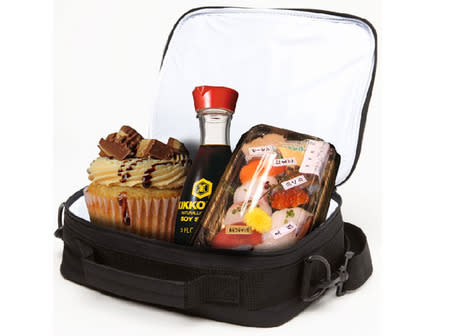The Most Dangerous School Lunches
Danielle Walsh

If you have a child in elementary school, chances are you know about food allergies and how they're handled in a cafeteria. The reign of peanut butter and jelly sandwiches is over, and notoriously difficult-to-open cartons of milk can't even be replaced by almond or soy milk. Sigh.
We know food allergies are serious (your humble writer has a tree nut allergy), and parents should check with schools before sending kids into the classroom with any of the 8 most common reaction-inducing foods for kids. But we've come up with the lunch you should never, EVER, bring into the modern food-allergy-filled school, no matter how much your child loves shellfish, eggs, or peanut butter. But first, some information about the Big Bad 8.
*Note: Children allergic to these ingredients can have symptoms as mild as a rash or as serious as anaphylaxis. We repeat: we are VERY serious about food allergies.
PEANUTS: Peanut allergies in kids have more than tripled in the U.S. since 1997. And as we all know, peanuts are legumes, not nuts-but if you're allergic to peanuts, you're 25-40 percent more likely to be allergic to tree nuts, too. Right now, 3.9 percent of kids under 18 have the allergy; about 20 percent of them will grow out of it.
TREE NUTS: While some kids are allergic to certain nuts and not others, it's best for them to avoid nuts altogether. And they should even avoid peanuts: Peanuts will sometimes be cross-contaminated with other nuts, which are often processed at the same plant. Among kids under 18, 1.1 percent have the allergy, and 9 percent grow out of it eventually.
See more: 7 Most Common French Toast Mistakes
MILK: Not-so-fun fact: Milk is the most common allergy in really young kids, affecting 2-3 percent of children under the age of 3. In some children, a reaction is triggered by a drop of milk; in others, a moderate amount sparks an issue. A lot of people make the mistake of confusing a milk allergy for lactose intolerance, but an allergy is the immune system reacting to a protein in milk. Lactose intolerance is an issue in the small intestine. The good news: 80 percent of kids grow out of this allergy by the time they're 5 years old.
FISH & SHELLFISH: Though they're common, 40 percent of fish and 60 percent of shellfish allergies tend to develop in adulthood-only 0.1 percent of kids are allergic to one, the other, or both. Because fish and shellfish aren't from related biological families, being allergic to one doesn't necessarily mean being allergic to the other. Even weirder, getting a reaction to crustaceans (shrimp, lobster, crabs) doesn't mean having a reaction to mollusks (scallops, clams, mussels, oysters). But just to be safe, those allergic to shellfish should just avoid the whole lot.
EGGS: Eggs, the seemingly unassuming household staple, are the second most common food allergy in kids: 1.5 percent of children have an egg allergy. But as with milk, most kids (70 percent) will outgrow it by age 16. Strangely, not the whole egg contains the histamine: the white is the culprit, housing a protein that triggers the reaction. But (duh) make sure your egg-allergic child isn't eating yolks just to be safe. Kids with egg allergies should also be wary of vaccines, because a lot of them contain egg proteins.
See more: Best. Sandwich. Ever.
WHEAT: Though 0.4 percent of kids are allergic to wheat, 80 percent will outgrow the allergy by 18. Most can eat cereals like barley, corn, oat, quinoa, and rice, but 20 percent of people with wheat allergies are also allergic to other grains. It's important to note that a wheat allergy is very different from a gluten intolerance or Celiac disease-an allergy is a reaction of the immune system, whereas the latter causes issues in the small intestine.
SOY: Another member of the legume family, soy triggers allergic reactions for 0.1 percent of kids. And though 50 percent end up outgrowing the allergy, those that don't have a higher chance of being allergic to other legumes (read: peanuts).
THE DEADLIEST LUNCH: Drumroll, please: Assorted sushi with soy sauce and, for dessert or snack time, walnut muffins with peanut butter frosting. Are we salivating, or is that just our throats closing up? Either way, better pack an EpiPen to be safe. On second thought, pack 10.
See more from Bon Appétit:
25 Quick and Easy School Lunches to Pack for Your Kids
10 Snacks You Thought Were Healthy But Really Aren't
The Best Restaurants in America
The Ultimate Chocolate Chip Cookie

